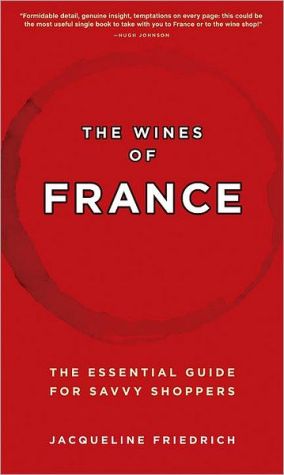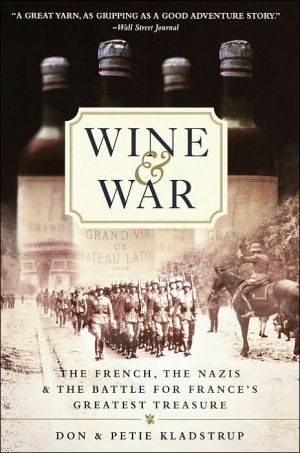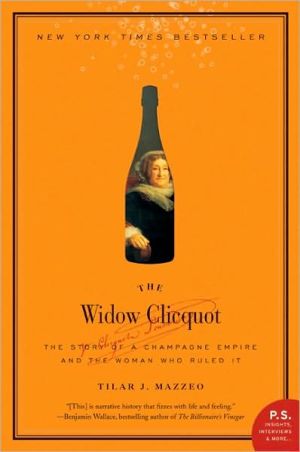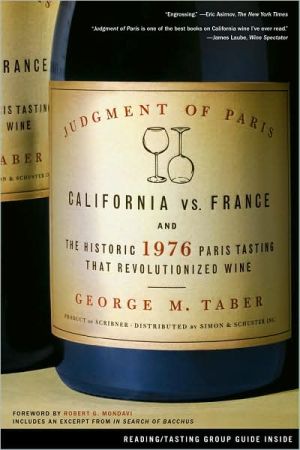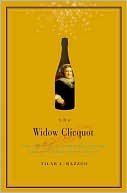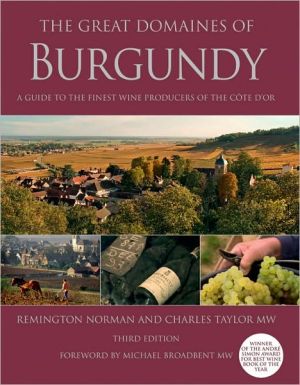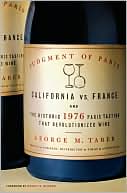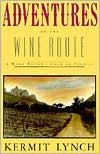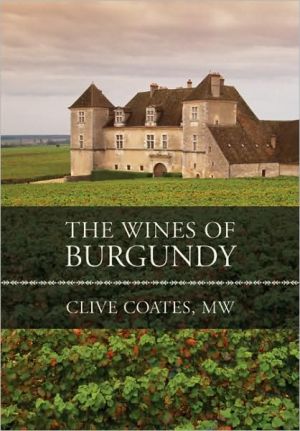Wines of France: The Essential Guide for Savvy Shoppers
Sure the labels are confusing and the pronunciation daunting, but France's wines continue to set the standard for excellence around the world. Whether you're well versed in French terroir or you're dabbling outside your comfort zone, this comprehensive guidebook will make you an expert in today's best and best-value wines from France. Jacqueline Friedrich's unpretentious tasting notes are utterly enjoyable and contain the perfect balance of information on specific wines, vintages, prices, and...
Search in google:
Sure the labels are confusing and the pronunciation daunting, but France's wines continue to set the standard for excellence around the world. Whether you're well versed in French terroir or you're dabbling outside your comfort zone, this comprehensive guidebook will make you an expert in today's best and best-value wines from France. Jacqueline Friedrich's unpretentious tasting notes are utterly enjoyable and contain the perfect balance of information on specific wines, vintages, prices, and producers. So, pour yourself a glass of Pouilly Fuiss?© (that's "pooh-YEE fwee-SAY"), sit back, and savor THE WINES OF FRANCE.
THE WINES OF FRANCE\ THE ESSENTIAL GUIDE FOR SAVVY SHOPPERS \ \ By JACQUELINE FRIEDRICH \ TEN SPEED PRESS\ Copyright © 2006 Jacqueline Friedrich\ All right reserved.\ ISBN: 978-1-58008-688-2 \ \ \ \ Introduction\ Recently I was dining in a nice little restaurant in an up-and-coming neighborhood in Paris. It was a casual storefront with ambitious food and a sensational wine list, featuring leading producers from emerging regions like Irancy, Collioure, Minervois, Cheverny, Faugères, and Pic St.-Loup. \ Now, the waitress could not have been more accommodating, but she knew zilch about wine. A pretty, smiling slip of a girl, she asked, "Red or white?" when I ordered a bottle of Chablis. And she gamely attempted to speak English with a couple from Massachusetts, who in turn, gamely tried to speak French, resorting to their dictionary to find the word for glass.\ Not an atypical state of affairs. But what would have happened had the New Englanders wanted more than just a glass each of the house red and had asked for suggestions on selecting a bottle? I can't imagine that that waitress, no matter how agreeable, could have intelligently advised the couple. What they needed, in addition to their dictionary, was a portable guide to the wines of France.\ Proselytizer that I am, I probably would have leaned back in my chair and given them a rundown on all the wines being offered. And that, in essence, is what I'm doing here. This book is meant to be your very own personal shopper, the busybody leaning over your shoulder, giving you the guidance you need to buy a bottle of wine you'll find delicious-no matter what the price or when you want to serve it, whether it's for a cozy meal in front of the TV or a lavish dinner party for so-called connoisseurs-like me.\ How did a middle-class girl from South Orange, New Jersey (that would be me) get to be such a maven? I was hardly to the manner born. My childhood home on your basic Norman Rockwell block was a wine-free zone. We drank milk, soda, fruit juice, coffee, and tap water (with ice made by the refrigerator). My first wine loves were Riunite Lambrusco, Lancers, and Mateus.\ Fast-forward through years of wine clubs, informal tasting groups, wine-motivated travel, an expanding wine library, not to mention a bulging wine "cellar," a move to France to write a book on the wines of the Loire, followed by years of crisscrossing the French vineyards, serving on wine juries, meeting, talking, listening, and tasting, tasting, tasting. But enough about me.\ My mission is to convince you that wine is not a closed, exclusive club. If I could learn, anyone can learn. And wine is actually an ordered universe. It's not random or chaotic, although, like art or music, it can be somewhat complicated. The world of wine is so interesting that the more you learn, the more you want to learn. Wine opens up all kinds of windows; it invites you into the culture and history of its place of origin. And it's just damned delicious.\ Now, a couple of words-maybe fighting words-about French wine. Starting with this: France is the greatest winemaking country in the world. And it always will be, at least in our lifetimes.\ France created the benchmarks for most, if not all, the classic wines in the world. That pinot noir they're freaking out about in the movie Sideways? Benchmark: Burgundy. That exciting sauvignon blanc from New Zealand? Benchmark: the Loire. That sensational shiraz from Australia? Benchmark: the Rhône. And so on.\ Further, no one country can compete with France when it comes to diversity. I don't mean simple diversity. Many countries are capable of making an encyclopedic range of wines, but only France has proved that it can excel in every last one of the styles.\ Wine is important to France. It's the country's primary agricultural export. And the history of wine in France is long and turbulent. Anything but calm, today's climate is best characterized by Dickens: it's the best of times and the worst of times.\ You may have heard about a crisis in French wine. Well, it's real, it's many-tentacled, and it won't be solved overnight. For one, France took too long to recognize that it was no longer the only kid on the block, that it has significant competition, particularly from what's called the New World. Global politics, the strength of the dollar, and labor costs all play a part. Important châteaux-Montrose, for example, or Taittinger-are sold daily. Disgruntled growers in the Languedoc make headlines when they loot and riot, demanding additional state aid. And quite simply France is making too much wine.\ That said, we are simultaneously living in a golden age of French wine. Many of the post-World War II practices that resulted in substandard wines are gradually but systematically being corrected. These practices included excessive grape yields (some as high as 150 hectoliters a hectare, which translates as close to eleven tons per acre), the harvesting of unripe grapes followed by the seemingly obligatory addition of industrial amounts of sugar to boost alcohol levels, and a general lack of hygiene. Further, "progress" came along in the form of mechanization (tractors, machine harvesters) and science (clones, aromatic yeasts, chemical fertilizers, and weed killers). Some of these were outright boons, making the vigneron's life easier; others would prove to be booby traps; and still others simply needed-and may still need-perfecting. Much of the worst wine was bottled and sold by négociants, who had come to be regarded as smirking, mustache-twirling villains.\ Over the past fifteen years I've witnessed a dramatic evolution toward quality-a general lowering of yields, although many are still too high; a serious reduction of chaptalization (the addition of sugar); more enlightened use of machine harvesters; and a decisive move away from chemical vine treatments. Additionally, cooperative cellars have improved radically. There are more than a few that are downright enlightened when it comes to grape growing, winemaking, and wine marketing. There's a new generation of négociants who seem every bit as artistic as some of France's most idealistic and scrupulous vignerons. The Vin de Pays category has exploded in several very interesting directions. Along with little country wines (sometimes charming, sometimes not), there are now varietal wines-labeled chardonnay, merlot, sauvignon blanc, and so forth-that are fully competitive with their New World analogues. And there are the iconoclasts making wines that don't fit within the letter of the law so they turn their backs on the supposedly prestigious Appellation Contrôlée status to which their wines might have been entitled had they been willing to conform to the law's dictates-like using only the grape varieties permitted for their location. Instead, much like Italy's super Tuscans, they "demote" their wines to Vin de Pays-although they're usually a whole lot more expensive than their Appellation Contrôlée counterparts. Taking matters still further are the exponents of two more trends: "cult" or "garage" wine and what I call hypernatural wine. I think of these developments as some sort of atonement for "the sins of the fathers."\ EXTREME WINES: THE WINES OF REDEMPTION\ What are they? Cult wines might be considered the Pradas of the wine world. Initially, they were dubbed "garage" wines because they were made-literally-in a garage by someone with a couple of rows of vines but no winery. The garagiste tended his or her small parcel of vines as assiduously as a city dweller fusses over the basil and chives growing in pots on the windowsill. This level of diligence was maintained even after the vineyards expanded exponentially and the winemaking was transferred to state-of-the-art facilities. The garagiste kept yields extremely low-say, 20 hectoliters per hectare (or 1.42 tons an acre), or even lower. Then came tender loving vinification in the cleanest of cellars and the priciest of new oak barrels. No expense was spared, including the hiring such of high-profile wine consultants as Michel Rolland. And the resulting wines were plush, immediately seductive, awash in sumptuous ripe fruit and fine oak flavors, and low in acid; any abrasive tannins were absent. Made like haute couture, they were as expensive as haute couture. The movement started on the Right Bank of Bordeaux, primarily in St.-Émilion, but has since spread throughout France.\ As for the hypernatural, you may have noticed that an increasing number of French wines are named after a specific soil type, like Didier Dagueneau's Silex. And that more and more winemakers put the humble tools of their trade, such as pruning shears, on the label. Here you have entered the world of the "Friends of the Earth." Ecologically friendly winemaking is one of the strongest trends in French viticulture. It takes a number of forms. The mildest is probably lutte raisonnée (literally, reasoned battle), a nondogmatic, basically undefined approach in which chemical treatments are used only when deemed absolutely necessary. Then there's organic winemaking. And there's the biodynamic method, a system whose principles were first spelled out by Rudolph Steiner, in which homeopathic vine treatments are used and vineyard operations are scheduled by the positions of the planets. Even more radical theories involve the influence of magnetic forces on wine.\ Hypernaturalism goes further. Hypernatural is a word I've coined to cover wines made with the least intervention possible, using wild yeasts, no chaptalization, no acidification, no fining, no filtration, no added sulfur. Here, the resulting wines range from a fuzzy brew that might have been made by a caveman to something as polished and magnificent as one of the Pradaish cult wines. One thing's for sure: purer wines you'll never taste.\ Both cult-garage and hypernatural wines are controversial for reasons too numerous and contentious to discuss fully here. I would just like to point out that when you are shopping there are a couple of things to bear in mind. Where the cult wines are concerned, particularly the reds, the grapes are so ripe, sometimes overripe, that the wines may be overwhelmingly rich. They may take on a Port-like aspect and have sweet (or sweet-seeming) finishes. If you're having a dinner party, however, a glass or two per person will surely please the crowd.\ Like the cult wines, hypernatural wines are also based on very low-yielding vines and very ripe grapes. By forgoing all the interventionist options, winemakers are, in effect, working without a net and exposing their wines to many risks that may result in off flavors and undesirable textures, some of which will disappear with aeration. When a wine has a prickly sensation for example, I simply pour it into a carafe and wait for it to settle down once it's had time to aerate.\ Detractors have little patience with either style. A pity. I feel both schools are part of the same revolution. There's a common search for quality, for excellence, and/or "truth"-an attempt to make the best wine that can possibly be made-the definition of best, of course, depending on your philosophical or gustatory orientation. And both are motivated by a similar repudiation of past abuses. High yields? We'll get the lowest yields possible. Dead soils owing to chemical fertilizers and weed killers? We go organic or biodynamic or a variation thereon. Unripe grapes? We'll get that fruit to ripen to previously unimaginable levels, even if that results in heavy, cloying, or fragile wines. Each school has pushed its theories to the limit.\ It is in the nature of revolutions to go too far. My hope is that with time (and luck) an equilibrium will be found. As vintners espousing either ideology feel less of a need to prove their point, when they realize they have essentially won the war, maybe they'll loosen up a bit and their wines will become less dogmatic. Or maybe I just want their Platonic idea of wine to correspond to my own.\ That's another thing about French wine: never a dull moment.\ (Continues...)\ \ \ \ \ Excerpted from THE WINES OF FRANCE by JACQUELINE FRIEDRICH Copyright © 2006 by Jacqueline Friedrich. Excerpted by permission.\ All rights reserved. No part of this excerpt may be reproduced or reprinted without permission in writing from the publisher.\ Excerpts are provided by Dial-A-Book Inc. solely for the personal use of visitors to this web site. \ \
